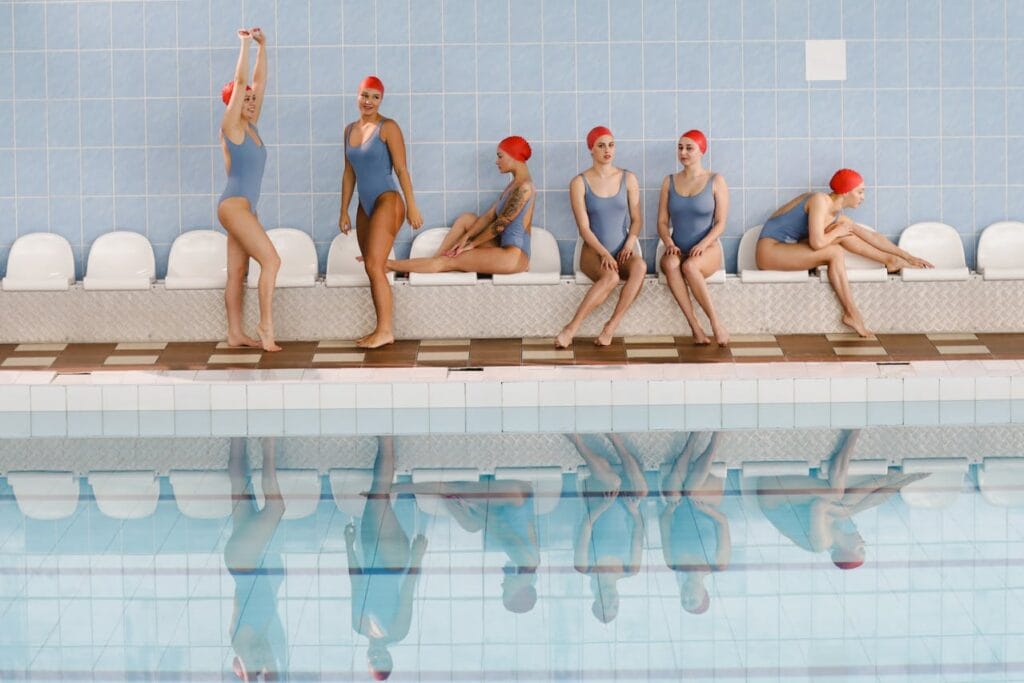Learn about What Are Bathing Suits. Discover the history, types, and materials of bathing suits. Learn how to choose the perfect swimsuit for your body type, activity level, and style preference.
Bathing suits or swimsuits are terms denoting clothing that is especially meant for an occasion-water or bathing- swimming by pool, basking in the sun, or water sports, but under safer use relative to the kind of bathing suit worn. Bathing suits were designed to fit different body shapes and personal preferences as regards style, material and appearance.
What Are Bathing Suits?
Bathing suits have traditionally been accepted as clothes to wear for swimming, work, or just fooling around at the beach or in the water. Very few other things describe them: bathing suits come in forms such as bikinis, swimsuits, trunks, and swim shorts.
The materials used in making bathing suits are normally quick-drying polyester, nylon, or spandex to delightfully cover every possible body type, offer stretchable comfort, and accommodate almost any potential choice.
History of Bathing Suits
Bathing suits have undergone quite an evolution from their ancient beginnings. While Greeks and Romans bronzed themselves in the buff, by the 18th Century, knee-length shorts had been donned by men and women covered from head to toe in bathing gowns.

Bathing suits became increasingly functional by the early 19th century, with the bikini arriving along with the 1940s. Bathing apparel has not been the same since. Today, swimwear is more about trends, comfort and function than anything else.
Types of Bathing Suits
1. One-Piece Swimsuits
A one-piece swimsuit has always been a good choice since it covers and supports the entire body. Competitive swimmers, those who want things covered up, and streamlining eyeballs prefer these suits. The styles vary quite a bit; some of them have high-cut legs, plunging necklines, and sporty designs all made to keep the comfort and utility levels up.
2. Bikinis
The bikini consists of two separate pieces, allowing greater choices and combinations in styling and coverage. Sporty to stingy will cover them all. Great for a beach day or sunbathing, bikinis are a perfect swimwear reference for anyone wishing to display their very own style.
3. Tankinis
A tankini is where bikini bottoms accompany a tank, providing a middle ground between sustaining comfort and looking good. Less revealing than a bikini yet equally stylish, these are for the ladies who want the elegance of two pieces with a tad more comfort. They come in various colors and designs.
4. Monokinis
Monokini swimsuits are an ingenious mixture of a one-piece suit and bikini with fancy cut-outs to let the curves breathe while having just enough coverage. Such chic designs are modern and appealing, particularly for those who have the confidence to flaunt such a costume type at the beach or pool.
5. Swim Trunks
Men adore these loose shorts as they use them with quick-drying materials and are also very cool to wear. They are typically busy moving from one chore to another: swimming, sunbathing beside the pool, or simply leisurely strolling on the beach. These swim trunks come in different lengths – some are nearly mid-thigh, while others go down to the knees.
6. Board Shorts
Board shorts are made for surfers and all those beachgoers who actively take part in beach-related activities. They are longer than typical swim shorts so that one can boost comfort, mobility, and strong protection against chafing. Drawstring waists, rip-resistant fabric, combined with being extremely comfortable, they are fit for really intensive water sports.
7. Rash Guards and Swim Shirts
Most times, it is equipped with maximum sun protection and some additional comfort during water activities. Rash guards generally resist the effects of UV rays. The fabrics are intended to help surfers and swimmers enjoy that sun exposure without the fear of sunburns, rashes, or abrasions, and keep moving freely at all times.
Benefits of Bathing Suits
1. Comfort and Flexibility
These garments are elasticized, mostly made from spandex and polyester, and thus very comfortable to be worn during swimming, sunbathing, or participating in any water sport. They also allow free movement in and out of the water.
2. Quick-Drying Fabric
Most of the time, the materials from which the swimsuits are made are those that quickly dry. Thus, discomfort due to wet conditions for long periods is avoided. This is helpful on beaches, by the poolside, and in water parks.
3. Protection from Sun and Chlorine
Multiple swimming suits are UV-protecting, thus protecting the skin from dangerous sun rays. In addition, high-end swimsuits are better at resisting chlorine, which eventually lengthens the duration during which the fabric does not fade.
4. Enhances Performance in Water
Swimwear is designed, mainly, to ensure the least possible water resistance and buoyancy at maximum, while swimming; the two criteria ensure efficiency of swimming. Professional swimmers depend on streamlined swimwear so that they can gain speed without resistance in the water.
5. Stylish and Fashionable
These days layout, color, and cut are all available on modern swimwear to cater to individuality in fashion choice. It could be a bikini, one-piece, or even swim trunks still have their place in uplifting confidence and style.
6. Provides Support and Coverage
There are swimsuits in many sizes and shapes. There is now a built-in bra, tummy control, and adjustability on some so that it can give much more support and coverage to make one feel more comfortable and confident about swimming.
7. Suitable for Various Activities
They can be worn while swimming, surfing at the beach, playing beach volleyball, and even doing some water aerobics. Some bathing suits make it to the casual beach lifestyle very easily.
Materials Used in Bathing Suits
- Nylon: Best for swimwear, nylon is very lightweight, drying very fast. Holds great flexibility and comfort, with the ability to mold tightly, but it is not very much resistant to chlorination. This might cause damage after a while of frequent exposure.
- Polyester: The Applicability of polyester is widespread, as it is the strongest of all and offers maximum resistance against both chlorine and UV rays. Most features of polyester fabric last longer compared to others in terms of color and shape retention. It is the best answer for those who are competitive swimmers or who swim often in pools and under the sun.
- Spandex (Lycra): Known as Lycra, this spandex contains the best elasticity and will stretch snugly and be comfortable. It provides room for movement through the improvement in flexibility. In chlorinated water and sunlight for prolonged periods, the degradation of Spandex begins.
- Neoprene: It is a layer of thermal insulation between the body and cold water during swimming. Hence, it keeps the heat inside. It does not flow through the wetsuit; thus, it creates buoyancy and thickness to resist water, a perfect match for surfing, diving, and other watersports.
How to Choose the Right Bathing Suit
Choosing the best swimwear, taking into consideration the various aspects:
- Body Type: Choose a silhouette for swimming that best complements your figure. For example, one-piece suits elongate the torso; on the other hand, high-wasted bikinis accentuate all those curves.
- Activity Level: A racer that cuts the wind to its advantage suits a professional swimmer; on the other hand, a beachgoer can be seen in various styles that reflect fun.
- Material & Fit: The material should feel right and bring a secure fit—never be uncomfortable.
- UV Protection: Rash guards or swim shirts with a UPF rating can help in avoiding sunburn.
Cultural and Regional Variations of Bathing Suits
Bathing suit styles and standards differ from one culture to another and even within a region. Bikinis and one-piece suits are popular in Western countries, whereas in conservative regions, such as certain parts of the Middle East, burkinis are preferred due to their complete covering. Many traditional swimwear items, such as the fundoshi in Japan and the lungis in South Asia, are also indicators of culture.

Environmental Impact of Bathing Suits
Making swimsuits, especially synthetic ones, generates concern for the ecosystem. Fashion of today has increased pollution with microplastics from bathing suits shedding and washing into water bodies. Eco- conscious consumers are now opting for clean-cut swimsuits like those made from post-recycled ocean plastic or biodegradable fabrics.
Customization and Trends in Bathing Suits
Custom tailormade swimsuits make it possible for everyone to personalize the colors, patterns, and styles in their swimsuits. Retro-inspired designs, high-waisted bikinis, minimalist cuts, and eco-friendly materials are some of the latest trends of such type. One of the technological innovations in modern swimwear is the smart swimwear with UV sensors.
FAQs
Can bathing suits be worn outside of swimming?
Certainly, plenty of contemporary bathing costumes can be worn casually. Some people tend to wear it with shorts or a skirt during beach visits or in a summer ensemble.
Can men wear bathing suits?
Yes, the men’s swim trunks could take the board shorts or briefs formats. As these swimming gears are designed to cover everything from comfort to performance to crashing waves, they are needed in almost every way.
Are bathing suits available in plus sizes?
Yes, there are plenty of brands making plus size bathing suits with body supportive styling, adjustable straps, and tummy control features for comfortable wear.
Where can I buy a good bathing suit?
Bathing costumes are available at departmental stores, swimwear boutiques, online entities, and from sportswear brands. Choose a trusted brand that offers quality and durability.
Conclusion
Bathing suits are an inseparable part of trying out water activities and come in a hundred different styles depending on the individual. From the full-body swimming costumes of yore to the trendy bikinis and function-based suits of modern-day, swimwear has always altered for function and fashion. Selecting the most appropriate bathing suit is based on comfort level, the activity to be undertaken, and his or her style preference, all of which ensure a good time in the water with confidence.
